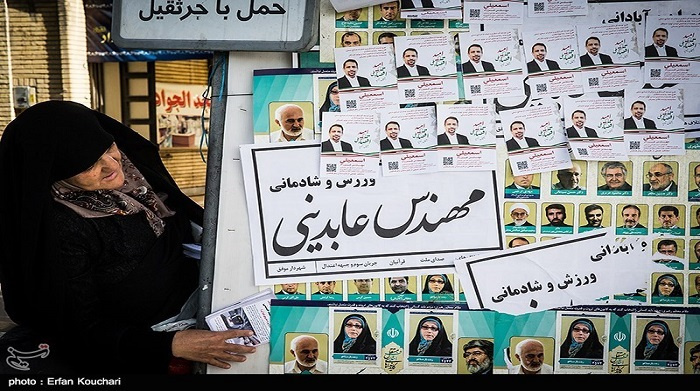Cold yet Competitive, Campaign Curfew Starts For Elections

Hessam Emami
Figures suggest the sweeping disqualification of reformist hopefuls has already partly determined the result of the parliamentary election in Iran to some extent as people in the country are still more inclined toward bold-face names, but is it not too early to count the chickens?
The two main camps, a coalition of moderates and reformists vis-à-vis principlists, are encouraging higher participation in the looming twin elections of the parliament and the Assembly of Experts in Iran. While principlists enjoy an advantage campaigning whether on streets, in meetings and state media, reformists have shifted focus more vehemently on social networks and media. Ping-pongs of accusations have already gone too far suggesting an adverse side is exposing the country to foreign manipulation plots or worse is afraid of a large turnout, supposedly the final nail in its coffin. The eliminating attitude on both sides has created a void of real plans in most campaigns even though the reformists have declared their vision of a more open political atmosphere and the principlists are vaguely speaking of future efforts to remedy the suffering economy. What has become of utmost importance for both parties is to block the other side’s radicals from the parliament, a bid partly already succeeded against many reform-oriented nominees barred during a strict process of vetting in the Guardian Council over alleged lack of practical adherence to Islam and the Constitution. Both sides are asking people to vote for their full lists in Tehran and other large cities to minimize chances of a single rival nominee winning a seat. With all these, the public and the elite are still in a state of confusion, unable to predict the results.
Figures and stats extracted from polls might be able to shed some light on the issue, but they are by no means definitive. A report published in Payesh Online on Monday says recent polls indicate that, although nominees who support the Rouhani-Rafsanjani-Khatami trio are more popular among Iranian voters, prominent individual principlist candidates still have higher chances of election compared with their pro-reform rivals.
Figures from four accredited polls conducted by the IRIB, Iranian Students’ Polling Agency (ISPA) and two unnamed institutes suggest that Gholamali Haddad Adel, Mohammadreza Aref, and Ali Motahari are the most popular nominees in Tehran, regardless of the electoral lists, though Haddad Adel’s like-minded peers have less chances of success in the parliamentary election.
The polls conducted last week estimate that Haddad Adel, a leading principlist nominee who tops a thirty-man conservative coalition list, will collect at least thirty percent of the total number of ballots in Tehran if no special campaigning wave rises in the final hours. However, if Tehrani citizens decide at the eleventh hour to vote for lists, the priniciplists will have highly slimmer chances and it is quite possible that no other priniciplist, i.e. except for Haddad Adel, can win a seat from Tehran. The full-list-vote initiative was a strategy originally of the reformists as a bid to block hawkish hardliners but has now become a trend in the playoff.
In the meantime, it is worth noting that even Haddad Adel’s popularity has seen a declining trend over the past few weeks, according to Payesh. In a poll conducted in early January, he had 36 percent of the votes, 33 percent on January 21, which went down to 31 percent on February 8.
All polls clearly show that most reformist nominees, whether in Tehran or across the country, are mostly little-known faces with less chances of victory relying on their individual capabilities. In fact, there are no other reformist names except Aref, Motahari, Mahjoub, and Jelodarzadeh among the first thirty in nearly all polls conducted in Tehran. However, if people decide to vote for lists, reformists will probably win 29 out of 30 seats from Tehran. For instance, a poll conducted on February 18, with a four-percent margin of error, asked participants whose supporters they want elected into the parliament. While 41 percent chose supporters of Rouhani and 21 percent those of Khatami, figures that could add up into a strong majority, 13 percent answered in favor of Haddad Adel, 8 percent were for Ali Larijani, a moderate also favorable among reformists with chances of leaning toward them, as only 4 percent chose Saeed Jalili’s supporters.
Although, most polls have shown higher popularity of the reformists and moderates across the country, an IRIB poll suggests the front cannot win more than a third of the Parliament seats because it fails to introduce prominent nominees in most constituencies. According to the stats collected in the poll that covered major cities in Iran, out of the 106 seats available to these constituencies, the principlists will be able to win more than eighty unless a ‘campaigning tsunami’ some reformists have promised starts, prompting a large wave in their support.
On the other hand, all the polls demonstrate that participation is increasing, thus predicting a higher turnout compared with the ninth parliamentary election. The reformists should await a miracle of a tsunami while the principlists should keep their fingers crossed that the participation rate does not go up any further, the report says.
Surveys in Iran are popularly considered to be politically manipulated, but it seems they still carry a shade of truth when it comes to elections. With the campaigning window closed, popular social media in Iran will have little more than 24 hours to play a decisive role, strengthening a front, attenuating chances of another, or regardless, increasing the participation rate.

